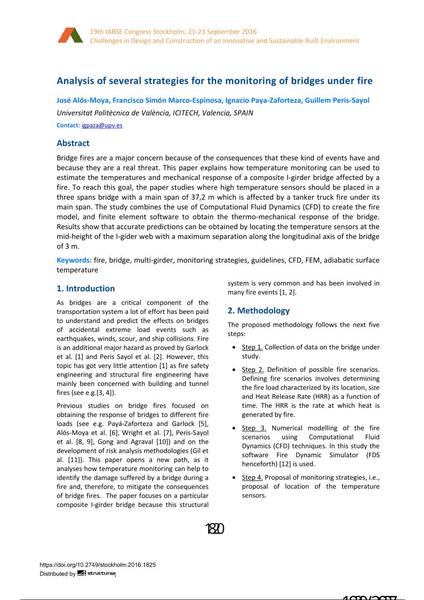Analysis of several strategies for the monitoring of bridges under fire

|
|
|||||||||||
Détails bibliographiques
| Auteur(s): |
José Alós Moya
(Universitat Politècnica de València, ICITECH, Valencia, SPAIN)
Francisco Simón Marco-Espinosa (Universitat Politècnica de València, ICITECH, Valencia, SPAIN) Ignacio Payá-Zaforteza Guillem Peris Sayol (Universitat Politècnica de València, ICITECH, Valencia, SPAIN) |
||||
|---|---|---|---|---|---|
| Médium: | papier de conférence | ||||
| Langue(s): | anglais | ||||
| Conférence: | IABSE Congress: Challenges in Design and Construction of an Innovative and Sustainable Built Environment, Stockholm, Sweden, 21-23 September 2016 | ||||
| Publié dans: | IABSE Congress Stockholm, 2016 | ||||
|
|||||
| Page(s): | 1820-1827 | ||||
| Nombre total de pages (du PDF): | 8 | ||||
| Année: | 2016 | ||||
| DOI: | 10.2749/stockholm.2016.1825 | ||||
| Abstrait: |
Bridge fires are a major concern because of the consequences that these kind of events have and because they are a real threat. This paper explains how temperature monitoring can be used to estimate the temperatures and mechanical response of a composite I-girder bridge affected by a fire. To reach this goal, the paper studies where high temperature sensors should be placed in a three spans bridge with a main span of 37,2 m which is affected by a tanker truck fire under its main span. The study combines the use of Computational Fluid Dynamics (CFD) to create the fire model, and finite element software to obtain the thermo-mechanical response of the bridge. Results show that accurate predictions can be obtained by locating the temperature sensors at the mid-height of the I-gider web with a maximum separation along the longitudinal axis of the bridge of 3 m. |
||||
| Mots-clé: |
pont
|
||||
